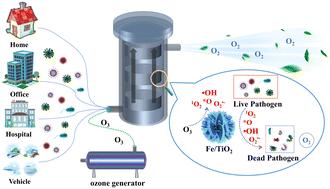利用 O3-Fe/TiO2 构建流动式催化反应器,实现高效催化臭氧消毒†。
IF 4.2
3区 化学
Q2 CHEMISTRY, PHYSICAL
引用次数: 0
摘要
要防止空气中微生物病原体的传播,保护公共安全,就必须采取有效的空气消毒方法。臭氧被认为是世界上一种广谱、经济的消毒剂,但臭氧的健康风险限制了它的实际应用。在这项研究中,我们设计了一种流过式 O3 催化剂反应器,通过将 O3 转化为活性氧(ROS)对空气进行消毒。优化后的 O3-Fe/TiO2 反应器具有显著的消毒效率,其对数(log)阶为 3.53(-log10 (C/C0)),是单独使用臭氧(8.2 ppm 臭氧和 93% 相对湿度)消毒效率的 22 倍。此外,O3-Fe/TiO2 反应器还表现出显著的消毒效率(99.5%)和良好的稳定性(80 小时),臭氧出口浓度低于 0.03 ppm,这是世界卫生组织空气质量指南推荐的标准值。自由基清除试验、电子顺磁共振(EPR)和原位拉曼研究表明,羟基自由基(-OH)在催化臭氧消毒中占主导地位。此外,理化表征、EPR 和电化学测量结果表明,分散良好的 FeOOH 使表面羟基的密度从 0.9 mM g-1 增加到 1.5 mM g-1,加速了臭氧与催化剂之间的电子转移,从而大大提高了 -OH 的产生,促进了细菌的不可逆灭活。该催化臭氧反应器的设计为露天场所和有人工作场所的高效生物气溶胶消毒铺平了道路,从而保护了公众健康并实现了连续生产。本文章由计算机程序翻译,如有差异,请以英文原文为准。

Construction of a flow-through catalytic reactor employing O3–Fe/TiO2 for efficient catalytic ozonation disinfection†
An effective air disinfection approach is necessary to prevent the spread of airborne microbial pathogens to protect public safety. Ozone is considered as a broad-spectrum and economical disinfection agent worldwide, while the health risks of ozone limited its practical application. In this study, we designed a flow-through O3–catalyst reactor disinfecting air by converting O3 into reactive oxygen species (ROS). FeOOH supported on TiO2 (Fe/TiO2) was prepared as a catalyst and the optimized O3–Fe/TiO2 reactor exhibits remarkable disinfection efficiency with a logarithmic (log) order of 3.53 (−log10 (C/C0)), which is 22-fold as high as that of ozone alone (8.2 ppm ozone and 93% relative humidity). Moreover, the O3–Fe/TiO2 reactor also exhibited significant disinfection efficiency (99.5%) and good stability (80 hours) with an ozone outlet concentration below 0.03 ppm which is the standard value recommended by the World Health Organization air quality guidelines. The radical scavenging tests, electron paramagnetic resonance (EPR), and in situ Raman studies indicated the hydroxyl radical (·OH) dominated the catalytic ozonation disinfection. Furthermore, physicochemical characterization, EPR, and electrochemical measurements revealed that the well-dispersed FeOOH increases the density of surface hydroxyl groups from 0.9 mM g−1 to 1.5 mM g−1 and accelerates the electron transfer between ozone and the catalyst, which greatly improves the production of ·OH and promotes the irreversible inactivation of bacteria. This catalytic ozonation reactor is designed and paves a promising way for efficient bioaerosol disinfection in open space and workplace with human beings to protect public health and achieve continuous production.
求助全文
通过发布文献求助,成功后即可免费获取论文全文。
去求助
来源期刊

Catalysis Science & Technology
CHEMISTRY, PHYSICAL-
CiteScore
8.70
自引率
6.00%
发文量
587
审稿时长
1.5 months
期刊介绍:
A multidisciplinary journal focusing on cutting edge research across all fundamental science and technological aspects of catalysis.
Editor-in-chief: Bert Weckhuysen
Impact factor: 5.0
Time to first decision (peer reviewed only): 31 days
 求助内容:
求助内容: 应助结果提醒方式:
应助结果提醒方式:


